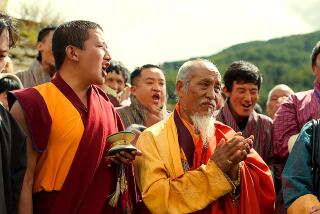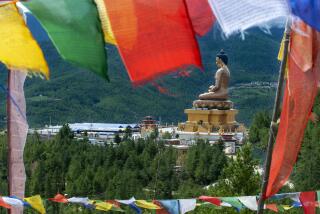Himalayan Kingdom’s Natural Beauty Is Unspoiled : Tiny Bhutan Is a Journey Back to Middle Ages
- Share via
PARO, Bhutan — Keiji Nishioka wakes up at dawn, feeds his eight dogs and then drives his Land-Rover into the Middle Ages.
Father William Mackey, a Canadian Jesuit, rises and dons the Bhutanese male’s traditional kho , a knee-length skirt, instead of his Jesuit robes.
The bespectacled 55-year-old Japanese farmer and the 73-year-old clergyman were among several foreigners who came to Bhutan in the 1960s when the remote Buddhist kingdom opened its doors to the outside world after centuries of self-imposed isolation.
Most left and now only Nishioka, Mackey and one or two Europeans have stayed on, lured by the stunning beauty, clean mountain air and the challenge of helping to develop Bhutan, an independent monarchy nestled in the Himalayas between India and Tibet.
‘Thunder Dragon’
Bhutan describes itself as “The Land of the Thunder Dragon” and is a country of pine-covered forests overlooking tranquil, unspoiled valleys where little appears to have changed since medieval times.
“I am intrigued by their philosophy, their village life, their ability to laugh at themselves. I just fell in love with the people and the country,” said Mackey, who arrived here 25 years ago and is now a Bhutanese citizen.
Abandoning a potential career as a hockey player to enter the priesthood, Mackey joined the Jesuit order in Guelph, Ontario, in 1932. He left for the northeast Indian tea district of Darjeeling to run a school in 1947.
In 1963 he started a school in Bhutan. A quarter of a century and several new schools later, he is now chief inspector of schools and helps draft education policies.
60 Years as Jesuit
“In Canada, I would have been a small cog in a big machine. Here, I can see a radical change between a family which has gone to school and one which has not,” said Mackey, who hopes to work in Bhutan until 1992, when he will have completed his 60th year as a Jesuit.
“My whole idea of Christianity has changed. I am richer after all these years of studying Hinduism and Buddhism. Back in Canada, they would call me a heretic.”
Mackey was awarded the title “Son of Bhutan” in 1973. He often receives mail addressed to Father W. Mackey, S.O.B., he said, adding, “I must be the only official S.O.B. in the Jesuit order.”
Nishioka has invested nearly half a lifetime away from his home in Japan in a Himalayan valley, teaching modern farming methods.
‘Work Appreciated’
“Here in Bhutan, when you hit the bell you can hear the sound. Things happen very fast here and my work is appreciated,” Nishioka said in a recent interview at the valley east of the capital Thimphu.
Nishioka taught for several years at a horticultural school in Osaka but left for Bhutan in 1964 as an agricultural adviser.
Working seven days a week, and often leaving his subordinates breathless with his drive, he has gone about his task with unstinting diligence, encountering some resistance before winning acceptance from Bhutanese.
“Paro people are very strong-minded. But more and more they are listening,” Nishioka said.
‘Chose to Live It’
Modest yet determined, he said: “Some people go away for a few years to earn money or gain a brief experience, and then spend the rest of their lives talking about it over drinks. I chose to live it here.”
After a quarter of a century of persuading and cajoling, he has come to be loved by virtually all 17,000 people in the valley as a hero of their own success.
The farmers were initially reluctant to try his farming methods or plant such unfamiliar vegetables as cabbage. He said he overcame the barrier by donating cabbages whenever there was a funeral.
“Soon, cabbages cooked with cheese became a favorite dish,” he said. Eventually, it became a major cash crop and Nishioka has also introduced tomatoes, asparagus and beans.
Successful Farmers
Farmers in the valley are the most successful in Bhutan. Their rice yield is nearly 4 1/2 times the national average of this country of 1.3 million people.
Nishioka’s greatest challenge came when he was asked in 1976 by King Jigme Singye Wangchuk to persuade 45,000 people in eastern Bhutan to abandon their shifting cultivation techniques.
It took him four years, but he succeeded. Few Asian nations have managed to halt traditional slash and burn farming techniques which cause erosion and widespread loss of forests.
More to Read
Sign up for Essential California
The most important California stories and recommendations in your inbox every morning.
You may occasionally receive promotional content from the Los Angeles Times.













